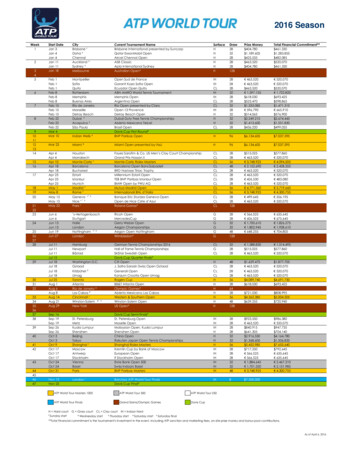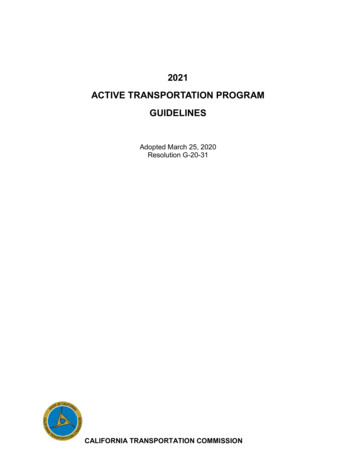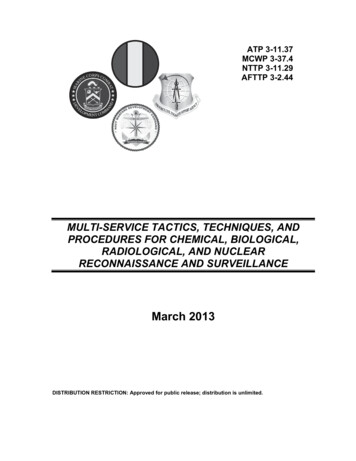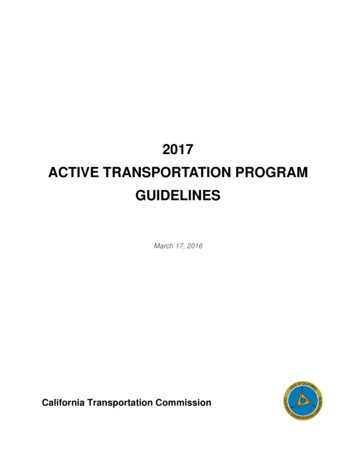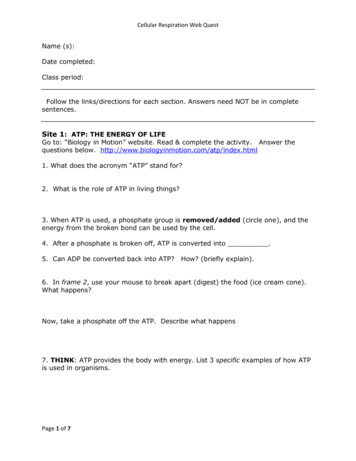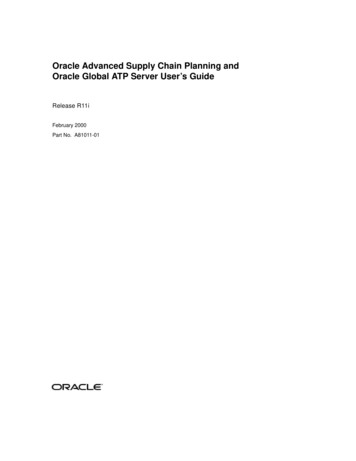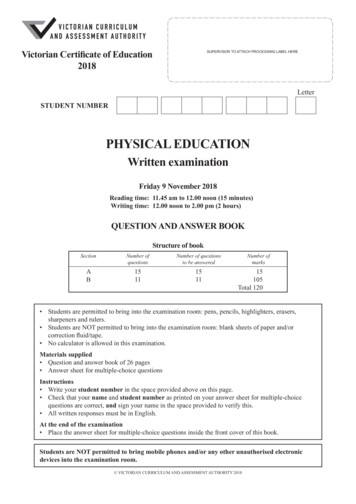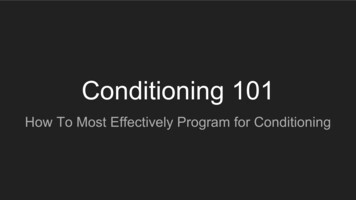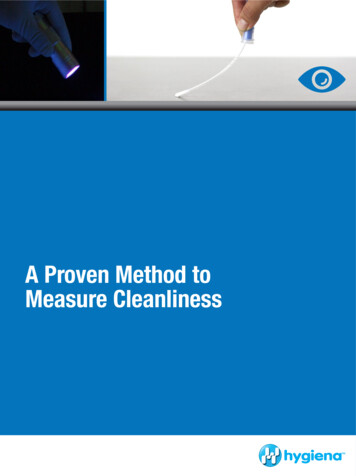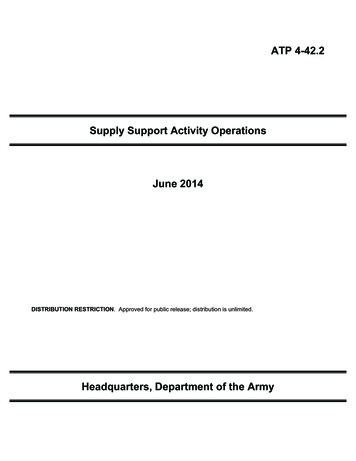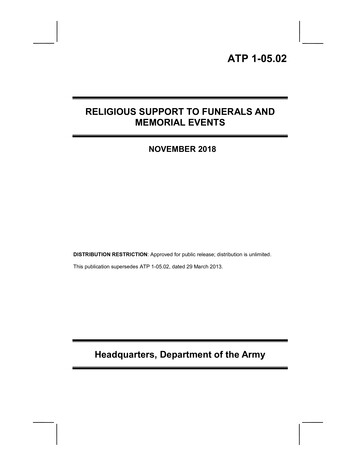
Transcription
ATP 1-05.02RELIGIOUS SUPPORT TO FUNERALS ANDMEMORIAL EVENTS129(0%(5 DISTRIBUTION RESTRICTION: Approved for public release; distribution is unlimited.This publication supersedes ATP 1-05.02, dated 29 March 2013.Headquarters, Department of the Army
This publication is available at the Army Publishing Directorate site(https://armypubs.army.mil), and the Central Army Registry d).
ATP 1-05.02HeadquartersDepartment of the ArmyWashington, D C , 1RYHPEHU 2018Army Techniques PublicationNo. 1-05.02Religious Support to Funerals and MemorialEventsContentsPagePREFACE . iiiINTRODUCTION . vChapter 1RELIGIOUS SUPPORT . 1-1Mission . 1-1Required Capabilities . 1-2Religious Support Core Competencies . 1-2Religious Support to Funerals and Memorial Events . 1-2Summary . 1-3Chapter 2MILITARY FUNERALS . 2-1Overview . 2-1Funeral Arrangements. 2-2Care to the Bereaved . 2-4Military Funeral . 2-4Other Considerations . 2-5Summary . 2-13Chapter 3MEMORIAL EVENTS . 3-1Overview . 3-1Memorial Ceremony . 3-2Memorial Service. 3-3Combatant Theater Memorial Events . 3-4Planning a Memorial Event . 3-4Ramp Ceremony . 3-5Summary . 3-6DISTRIBUTION RESTRICTION: Approved for public release; distribution is unlimited.This publication supersedes ATP 1-05.02, dated 29 March 2013. 73 i
ContentsAppendix A MEMORIAL EVENT TEMPLATES AND RESOURCES . A-1Appendix B MEMORIAL EVENT PLANNING CONSIDERATIONS . B-1GLOSSARY .Glossary-1REFERENCES. References-1INDEX .Index-1FiguresFigure 1-1. Religious support logic map .1-1Figure 2-1. Arrival of casket and escort into chapel .2-7Figure 2-2. Movement in the chapel .2-8Figure 2-3. Procession out of chapel .2-9Figure 2-4. Arrival of casket and escort to gravesite .2-11Figure 2-5. Graveside service .2-12Figure A-1. Sample memorial ceremony narration . A-7Figure A-2. Last roll call . A-10TablesTable A-1. Pre-event planning timeline . A-2Table A-2. Day of event planning timeline . A-3iiATP 1-05.02 1RYHPEHU
PrefaceATP 1-05.02, Religious Support to Funerals and Memorial Events, providesfundamental doctrinal guidance on the execution of funerals, memorial ceremonies, andmemorial services.The primary audience for ATP 1-05.02 is chaplains and religious affairs specialistsassigned to operational units to execute decisive action. It is also applicable to chaplainsections and unit ministry teams providing support to operational units as part of theiroverall mission. Trainers at combat training centers and educators throughout the Armyalso use this publication.Commanders, staffs, and subordinates ensure their decisions and actions comply withapplicable United States, international, and in some cases, host-nation laws andregulations. Commanders at all levels ensure that Soldiers operate in accordance withthe law of war and the rules of engagement. (See FM 27-10.)ATP 1-05.02 applies to the Active Army, Army National Guard/Army National Guardof the United States, and the United States Army Reserve, unless otherwise stated.The proponent for ATP 1-05.02 is the United States Army Chaplain Center and School.The preparing agency is the Doctrine Division, Capabilities Development IntegrationDirectorate, United States Army Chaplain Center and School. Send comments andrecommendations on DA Form 2028 (Recommended Changes to Publications andBlank Forms) to Commandant, United States Army Chaplain Center and School, ATTN:ATSC-DCDID (ATP 1-05.02), 10100 Lee Road, Fort Jackson, SC 29207-7000 or callcommercial; (803) 751-9173/DSN 734-9173. Follow DA Form 2028 format whensubmitting recommended changes. 1RYHPEHU ATP 1-05.02iii
This page intentionally left blank.
IntroductionATP 1-05.02 establishes a common understanding, foundational concepts, and methodsfor executing religious support during funeral services and memorial events.ATP 1-05.02 provides comprehensive doctrinal guidance on religious supporttechniques for chaplains and religious affairs specialists. The techniques contained inATP 1-05.02 serve as a guide and are not considered prescriptive. ATP 1-05.02 nestswith FM 1-05.ATP 1-05.02 was written for chaplain sections and unit ministry teams at all echelonsreligious support in an operational environment. While written for an operationalenvironment, the concepts and principles are also applicable in a garrison setting. It alsoprovides the chaplain corps technical chain with guidance to execute supervisoryrequirements during the funeral or memorial process. Chaplains and religious affairsspecialists serving in a joint force land component command or a joint task force shouldrefer to JP 3-0, JG 1-05, and other joint planning publications for further guidance.ATP 1-05.02 contains three chapters and two appendixes:z Chapter 1 reviews the chaplain corps mission, chaplain corps capabilities,religious support core competencies, and religious support to funerals andmemorial events.z Chapter 2 describes funerals, including arrangements, care to the bereaved,military funeral considerations, chapel funerals, graveside services, andpresentation of the flag.z Chapter 3 describes the differences between memorial ceremonies,memorial services, combatant theater memorial events, and rampceremonies, and concludes with a discussion of planning considerations andactivities.z Appendix A provides templates covering planning timelines, sample scriptoutlines, the last roll call, and questions to support checklist development.Several resources are provided which support the conduct of funerals,memorial ceremonies, and memorial services.z Appendix B provides a discussion of special planning considerations whichare distinct to the conduct of memorial events. 1RYHPEHU ATP 1-05.02v
This page intentionally left blank.
Chapter 1Religious SupportMISSION1-1. The mission of the Army Chaplain Corps is to provide religious support (RS) tothe Army across the range of military operations by assisting commanders in providingfor the free exercise of religion and providing religious, moral, and ethical advisementand leadership. (See figure 1-1.)Figure 1-1. Religious support logic map 1RYHPEHU ATP 1-05.021-1
Chapter 1REQUIRED CAPABILITIES1-2. The Army requires chaplain sections and unit ministry teams (UMTs) to provideRS and advisement to commanders on the impact of religion. These two requiredcapabilities reflect the dual role of the Chaplain Corps, religious leader and professionalmilitary religious advisor:z As religious leaders, the Army requires the capability to provide RS acrossaustere and isolated locations which accommodates service members’ rightto the free exercise of religion and supports resiliency efforts to sustainservice members in combat. RS tasks sustain the individual service member,extending upward throughout the entire command structure and outward tothe broadest command audience authorized. RS is comprehensive becauseevery individual personally defines what constitutes RS. While not everyreligious need of every Soldier can be met, chaplains and religious affairsspecialists seek to meet as many needs as possible.z As the professional military religious advisor, the chaplain advises thecommander and staff on religion, ethics, morals, and morale, and their impacton all aspects of military operations.RELIGIOUS SUPPORT CORE COMPETENCIES1-3. The three core competencies of the Chaplain Corps provide a clear and consistentway of conveying expectations of the dual role of chaplains as religious leaders andprofessional military religious advisors. These provide focus and direction for theChaplain Corps’ execution of its critical RS mission to nurture the living, care for thewounded, and honor the dead. (See FM 1-05 for more discussion on RS corecompetencies.)RELIGIOUS SUPPORT TO FUNERALS ANDMEMORIAL EVENTS1-4. As an integral part of the three core competencies, chaplains provide religioussupport during funeral services and memorial events. A memorial event may beperformed by a unit following the death of a Soldier in an operational environment (OE).A unit may perform a memorial event at home station in a post chapel, the post theater,or another appropriate facility. A chaplain may offer a prayer during a ramp ceremonyon an airfield in an OE. A funeral may be rendered at a local cemetery, the post chapel,or at a location selected by the Family. A chaplain may conduct a funeral for Soldiers,retirees, uniformed members of a joint force, authorized civilians, or Family members.These time-honored traditions are part of the Army profession.1-5. The chaplain’s primary role during military funerals and memorial events is toensure the religious portion is provided for with sensitivity to the religious and emotionalneeds of the Family and the military unit of the deceased. The chaplain section orUMT encourage a positive tone and attitude in the unit, prepares an appropriate order of1-2ATP 1-05.02 1RYHPEHU
Religious Supportworship, a message of hope, or an appropriate memorial event to address Family andunit needs.1-6. The chaplain is a personal staff officer advising commanders in matters pertainingto the religious aspects of military funerals and memorial events. Due to the religiousdiversity of the nation and Army, all chaplains must know the funeral practices andreligious requirements of various faith groups in the military. The chaplain advisescommanders on matters that pertain to the religious aspects of funerals or memorialevents and may be directed by commanders to oversee the coordination of other details.As a special staff officer, the chaplain, working on behalf of the commander, coordinateswith other agencies and sections to provide a well-coordinated event. As religiousleaders, chaplains play an important role in the Army’s tribute to Soldiers and thoseauthorized civilians who have honorably served their nation.1-7. The religious affairs specialist coordinates support for the chaplain throughout theentire process of advising, planning, and providing an event. (In the absence of areligious affairs specialist, the chaplain will coordinate these duties and responsibilities.)With the chaplain’s guidance, the religious affairs specialist—z Consults relevant standard operating procedures (SOPs) and currentregulations to coordinate and complete the necessary administrative supportand tasks.z Ensures the chapel or similar site is properly set-up in accordance with localSOPs, regulations, the chaplain performing the service, and anydenominational or faith-specific requirements.z Plans and coordinates security considerations for the chaplain in an OE.z Serves as a liaison between the command; the chapel, church staff, ormemorial site personnel; and if applicable, the burial detail and keepsappropriate leaders informed regarding any “last minute” adjustments.SUMMARY1-8. Chaplain sections and UMTs provide pastoral care to Family and friends, executefunerals and memorial events, and coordinate the support required to properly executethis type of religious support mission. Wherever they are conducted, and regardless ofthe tasks or order of events, military funerals and memorial events pay tribute to thosewho have honorably served the nation. Each final tribute draws from national, military,and religious traditions, not routinely nor impersonally, but profoundly and withcompassion. 1RYHPEHU ATP 1-05.021-3
This page intentionally left blank.
Chapter 2Military FuneralsOVERVIEW2-1. Religious support facilitates honoring the deceased. Chaplain sections and UMTsrevere those who have died, lay to rest those who have served the nation with dignityand honor, and treat their Families with respect and compassion. Funerals reflect theemphasis the American people place on the worth and value of the individual. Chaplainsections and UMTs conduct funerals in accordance with TC 3-21.5. Supervisors trainsubordinates on the proper roles and responsibilities of the chaplain and religious affairsspecialist during a military funeral. It is Department of the Army (DA) policy to provideMilitary Funeral Honors (See AR 600-25) for all present and former military personnelusing the following guidelines—z Medal of Honor recipients, active duty Soldiers, and retirees are provided fullMilitary Funeral Honors with a service detail consisting of a 9-member team.z Veterans are entitled to Military Funeral Honors with a service detailconsisting of at least 2 uniformed military members, at least 1 of whom willbe from the parent service of the veteran.z Every effort will be made to obtain a live bugler to play “Taps.”z Local commanders determine the availability of their resources as theypertain to Military Funeral Honors support, the composition of the burialhonors details, and any restrictions relating to military honors.2-2. Military funerals are divided into two classes: chapel service, followed bymovement to the grave or place of local disposition with the prescribed escort, andgraveside service only. (For further information on burial honors and the compositionof funeral escorts, see AR 600-25.) The word “chapel” is interpreted to include church,home, or other place where services are held, other than the service at the grave. (SeeTC 3-21.5 for more information on military funerals.)2-3. There are three types of military funerals that may be performed. They include—z A full military funeral that normally consists of, or is supported by, a 9-personfuneral detail, with the following elements: Casualty assistance officer (CAO). Officer in charge (OIC) or noncommissioned officer in charge (NCOIC)(appropriate for the rank of the deceased). One bugler to play “Taps” (or an electronic recording). Six active duty pallbearers and firing party. (This is a dual function, asthe pallbearers also serve as the firing party and will render these honors). Military clergy (if requested and available). 1RYHPEHU ATP 1-05.022-1
Chapter 2If resources permit, a larger funeral detail may be provided, which iscomposed of all the elements of the nine-person funeral detail, and may alsoinclude the following: Colors. Separate firing party (no more than 8, or less than 5, riflemen). Hearse (caisson). Honorary pallbearers. Personal colors (if appropriate). Escort unit or units (appropriate for the rank of the deceased).z A two-man military funeral honors detail consists of the following elements: An OIC or NCOIC (appropriate for the rank of the deceased). An enlisted Soldier. 1 bugler to play “Taps” (or an electronic recording).(See TC 3-21.5 for more information on military funerals.)zFUNERAL ARRANGEMENTS2-4. The casualty assistance center provides burial honors for deceased Armypersonnel including active duty and retired personnel as well as eligible ReserveComponents and authorized veterans when requested by the Family. Chaplain sectionsand UMTs consult local SOPs for notification procedures. Chaplain sections and UMTsmust be prepared to call these individuals as soon as possible when notified:z Supervisory chaplain.z Chain of command.z Honor guard NCOIC or OIC.z Funeral director.z Immediate Family.Note. In most cases chaplain sections and UMTs will have 24-72 hours’ noticebefore a funeral.2-5. Chaplains are action officers in that they prepare and conduct funeral services.Religious affairs specialists help coordinate with CAOs, funeral directors, chapel orchurch staffs and other applicable agencies, and they provide support as directed by thechaplain and local SOPs.2-6. Chaplains may conduct services for both active and retired, and eligible membersof their Families, at the request of survivors. If a graveside funeral is conducted, theFamily may provide input regarding honors provided. The desires of the Family aregiven the fullest consideration. Funerals conducted following the death of a Soldier orFamily member from a unit are usually conducted by the assigned chaplain. At othertimes, a chaplain may be assigned to funeral duty through a tasking from installation orhigher headquarters in accordance with a DA Form 6 (Duty 5oster). (See AR 220-452-2ATP 1-05.02 1RYHPEHU
Military FuneralsIRU more information on duty rosters.) Depending on the needs of the Family, funeralsmay be conducted locally and the chaplain and honor guard may have to travel to adistant location to perform this mission. In either case, the chaplain will be trained andready to perform this duty with care and pastoral compassion. For planning purposes,chaplain sections and UMTs consider the following guidelines when planning a funeralservice and when talking with the Family—z When possible, a chaplain of the same faith tradition of the deceased willconduct the funeral.z When possible, the chaplain will perform a funeral service which balancesthe traditions of the officiating chaplain or clergy with the desires of theFamily without compromising the chaplain’s endorsing agency’sexpectations.2-7. Upon notification, chaplains and religious affairs specialists need to quicklyidentify some basic information from the casualty assistance center, funeral director, andFamily that may impact planning and execution of a funeral service. This informationincludes—z Who will officiate, a chaplain or civilian clergy?z What are the Family’s desires? Did they request scripture, poem, hymn, orfaith-specific requirements?z Where will the funeral be held? Will it be at a funeral home, chapel, church,synagogue, mosque, or graveside?z When will the funeral occur (date and time)?2-8. As part of the planning process, chaplains serve as advisors to Families onappropriate options honoring their departed loved one, including serving as a decisionmaker should a Family desire something inappropriate. It is critical that the chaplaincontact the Family before the funeral service, either by visiting at the funeral home, or,at the very least, contacting them by telephone. The primary responsibility for funeralarrangements rests with the Family. The Family (or its representative) determines whoconducts the service and the extent of the military chaplain’s participation. The Familydecides where the body is to be buried and whether a chaplain or a civilian clergy personwill conduct the service. The Family of the deceased (or its representative) may requestanother clergy to officiate in lieu of a military chaplain. A civilian clergy person canconduct all religious elements of a military funeral or interment. (For furtherinformation, see TC 3-21.5 and AR 600-25.)2-9. Chaplains should make every effort to comply with Family desires, as regulationand protocol permit. At no time will chaplains not need to perform services that are atvariance with the tenets of their faith. If the Family opts to have a service withoutmilitary honors, a chaplain may not be required.2-10. Although chaplains will not need to perform services that are at variance with thetenets of their religion, they may still function as an escort to civilian clergy during agraveside with military honors. Chaplains may be called on to assist or advise civilianclergy and Family members with the ceremonial movement aspects of a military funeral.The chaplain briefs other officiants on the military aspects of the funeral and escorts the 1RYHPEHU ATP 1-05.022-3
Chapter 2officiant outside the chapel during the military portion. The officiant may walk with thechaplain to the graveside.2-11. As with any mission, a well-executed rehearsal by all participants (including thechaplain and honor guard) is required to finalize the concept of operations and renderthe highest quality funeral and graveside service. If possible, the primary participantswill meet at least once 24 hours before the event to coordinate the honors and sequenceof events outlined by the chaplain and OIC or NCOIC.2-12. During the funeral, one member of the family will be presented with the U.S. flag.In some cases, families may be divided over who should be entitled to receive the flag.The chaplain must understand the situation, compassionately listen, and be supportive.(For more detail, see DODI 1300.18 for a full definition of next of kin).CARE TO THE BEREAVED2-13. Chaplains hold two roles as clergy and special staff officers when honoring thedead. As clergy, they are responsible for the religious service. As special staff officers,they provide the final tribute to deceased service members and represent the commandto which they are assigned. The chaplain serves as pastor, counselor, and friend to theFamily and friends of the deceased.2-14. Pastoral care may be given before and after the funeral service through chaplainvisits to the Family. The chaplain can provide a supportive spirit to the bereaved byproviding hope for the future in the face of death. It is important for the chaplain toremember that for some religious traditions, religious rites and sacraments are importantin spiritual healing.MILITARY FUNERAL2-15. A full military funeral applies to all military funerals, with distinctions being madeaccording to the rank of the deceased. (For more detail on funeral rank distinctions, seeAR 600-25.)2-16. When the funeral is held in a military chapel, the chaplain will consult local SOPsfor guidance in arranging the funeral. A chapel funeral service or Mass may last between20-30 minutes. Timing may be critical when coordinating with the honors team waitingat the graveside or if the chapel is needed for another funeral. The funeral chapel serviceis followed by the movement to the grave or place of interment.2-17. For a graveside service, the funeral procession will form at the entrance or at apoint within a reasonable distance from the cemetery. The chaplain may travel with theFamily to the cemetery. Usually the chaplain will ride with the funeral director, marchin front of the caisson (for a short distance) or be pre-positioned at the graveside. Thechaplain stands next to the OIC or NCOIC at the curb, near the grave site, and salutes asthe hearse passes. If the chaplain’s first personal contact with the Family occurs at thecemetery, the chaplain will go to the Family car to meet them and then return to theoriginal position at the curb. Then the graveside service is conducted.2-4ATP 1-05.02 1RYHPEHU
Military Funerals2-18. When the remains are cremated and the ashes interred with military honors, thestandard funeral service is used with necessary modifications. (For more detail oncremation, see TC 3-21.5.)2-19. When asked to share in a joint worship service with another member of the clergy,chaplains are guided by policies set by their denomination or endorsing agent. Thechaplain participates and is sensitive to the needs of civilian clergy chosen by theFamily. When the funeral is conducted at a civilian church, synagogue, or mortuary, thechaplain co-officiates at the funeral. In such cases, the chaplain presides when militaryhonors are rendered.2-20. The Family or representative of the deceased may request fraternal or patrioticorganizations, of which the deceased was a member, to take part in the funeral service.With immediate Family approval fraternal or patriotic organizations may conductgraveside service activities at the conclusion of the military portion of the ceremony,signified by the flag presentation to the next of kin and escort departure from thecemetery. (See TC 3-21.5 for more information on graveside services.)OTHER CONSIDERATIONS2-21. Weapons which are not part of the ceremony (in a memorial stand and honorsfiring team) are generally not carried into a military chapel; excluding OEs. Exceptionsfor this might include on-duty military and civilian law enforcement personnel. Atoff-post locations and facilities, the OIC, NCOIC, or chaplain will follow the directionsof the lead representative for the respective location or facility regarding the presence ofweapons.2-22. The chaplain uncovers both inside and outside the chapel if wearing vestments,unless a liturgical headdress is worn. The chaplain in uniform uncovers inside the chapeland covers outside the chapel (unless standing under a roof or canopy). All personnelexcept active pallbearers follow the example of the chaplain in uniform.2-23. As part of the overall planning and rehearsal process, if vestments are required,chaplains allow time to change quickly because the overall time allotted for the funeral,graveside service, and final honors for the Service member may be limited. Chaplainsmay consider wearing vestments to the graveside or incorporating the religious affairsspecialist into the plan to help them quickly change at an appropriate moment followingthe funeral service.2-24. Planning must also consider weather and any required clothing (including ajacket, raincoat, hat, or gloves) that must be removed (after entering the chapel) or puton (during movement to graveside). (For further information on weather and requiredclothing, see TC 3-21.5.) Chaplains ensure that all participants (including the religiousaffairs specialist, OIC, NCOIC, CAO, and funeral director) understand the inclementweather plan and are briefed on any required changes to the sequence of events or delays.2-25. Military personnel and honorary pallbearers in uniform face the casket (which iscovered by the flag) and execute the hand salute as follows— 1RYHPEHU ATP 1-05.022-5
Chapter 2zzzzzAt the sound of honors.When moving the casket (except when they themselves are moving).During cannon salutes.During the firing of volleys.When “Taps” is being played.CONDUCTING A CHAPEL FUNERALNote. See TC 3-21.5 for procedures for conducting a funeral in a chapel with fullmilitary honors and working with a two man detail. Paragraphs 2-26 through2-36 depict the chaplain’s sequence of events for a full honors funeral.Not all elements may be present at every funeral. The actual concept ofoperations may vary and necessitate required changes based on the layout andany specific requirements of the cemetery or chapel facility, requirements of theHonor Guard or needs of the Family. Figures 2-1 through 2-5 (on pages 2-7through 2-12) provide diagrams for general planning purposes. Chaplains willrehearse with their Honor Guards before funerals to finalize the funeral andgraveside service scheme of maneuver, placement of the participants, and anyspecified cues required during the execution of the funeral or graveside service.2-26. During entry into chapel (see figures 2-1 and 2-2 on page 2-8)—z The chaplain will either be in position at the curb next to the OIC or NCOICor at the chapel door.z The chaplain salutes as the caisson or hearse passes and the casket isremoved.z The chaplain comes to order arms and leads the procession into the chapel,up the aisle, and into position.2-27. During the procession out of the chapel (see figure 2-3 on page 2-9)—z After the service, the casket is turned and the chaplain leads the processionout of the chapel.z The chaplain either returns to the curb next to the OIC or NCOIC or remainsat the chapel door, stands at attention and salutes as the casket is loaded intothe caisson or hearse.2-6ATP 1-05.02 1RYHPEHU
Military FuneralsFigure 2-1. Arrival of casket and escort into chapel 1RYHPEHU ATP 1-05.022-7
Chapter 2Figure 2-2. Movement in the chapel2-8ATP 1-05.02 1RYHPEHU
Military FuneralsFigure 2-3. Process
memorial services, combatant theater memorial events, and ramp ceremonies, and concludes with a discussion of planning considerations and activities. zAppendix A provides templates covering planning timelines, sample script outlines, the last r
